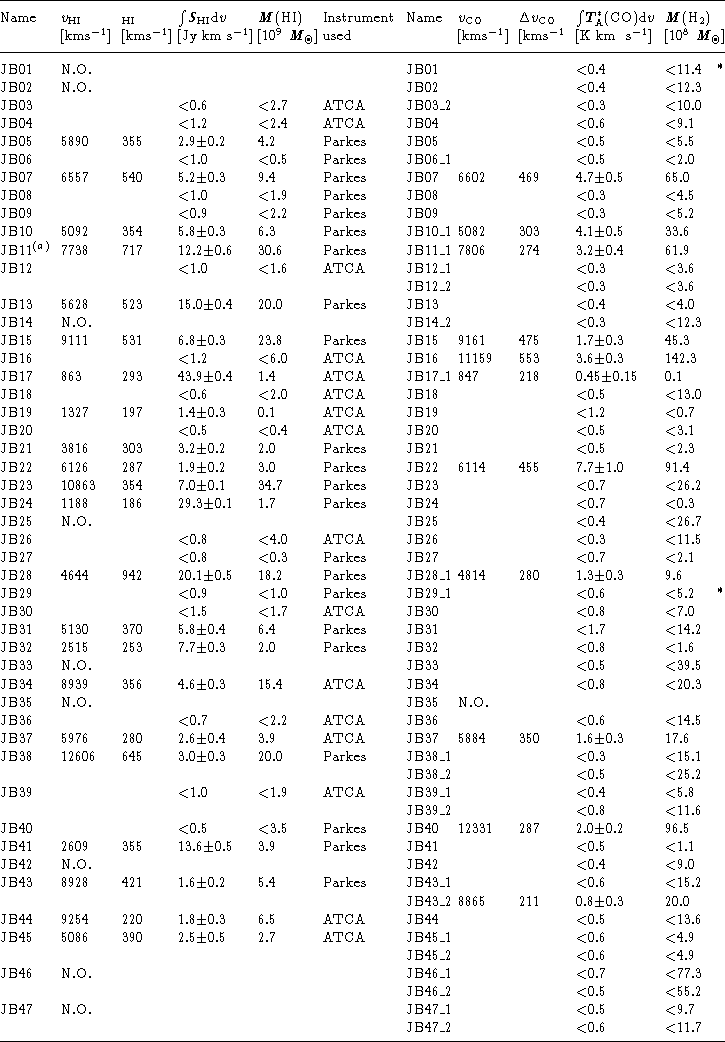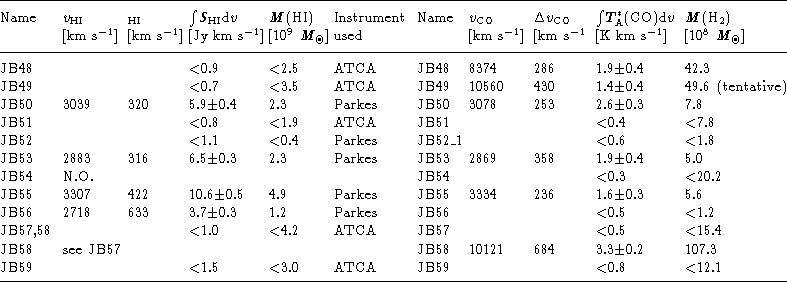The ![]() and CO spectra are shown in Fig. 3 (click here) for a few
galaxies of the sample. The entire dataset is presented in the electronic version
of the paper. The results are listed in Table 3 (click here), arranged as follows:
and CO spectra are shown in Fig. 3 (click here) for a few
galaxies of the sample. The entire dataset is presented in the electronic version
of the paper. The results are listed in Table 3 (click here), arranged as follows:
- Columns 1 and 7: Galaxy number adapted from
Johansson & Bergvall (1990).
The ![]() data refer to the entire system; in some cases, the two galaxies have
been observed in CO.
data refer to the entire system; in some cases, the two galaxies have
been observed in CO.
- Columns 2 and 8: Radial velocity (in the radio convention).
For the detected galaxies, the centroid velocity of the ![]() and CO line is given.
For the non-detected ones, the values have been taken from NED or given
by Bergvall (private communication).
N.O.= not observed.
and CO line is given.
For the non-detected ones, the values have been taken from NED or given
by Bergvall (private communication).
N.O.= not observed.
- Columns 3 and 9: Linewidth at the base of the ![]() and CO profile.
and CO profile.
- Columns 4 and 10: Integrated ![]() and CO line intensity.
and CO line intensity.
- Column 5: ![]() mass.
mass.
- Column 6: Instrument used for the ![]() observations: ATCA (Australian Telescope
Compact Array) or Parkes.
observations: ATCA (Australian Telescope
Compact Array) or Parkes.
- Column 11: H2 mass. The asterisk indicates the galaxies with
uncertain positions (![]() arcsec).
arcsec).

Table 3:
![]() and CO, observational results
and CO, observational results

N.O.: Not observed.
*: Galaxies with uncertain positions (![]() arcsec).
arcsec).
(a) JB11: for the HI, the pointing was made toward the position
between the two galaxies JB11_1 and JB11_2: 01h35m50.5; -65d09m02.
Table 3: continued
![]() fluxes exist in the literature for two galaxies of the sample, JB17 and JB24
(Huchtmeier & Richter 1989). Our ATCA data give a lower value for the
fluxes exist in the literature for two galaxies of the sample, JB17 and JB24
(Huchtmeier & Richter 1989). Our ATCA data give a lower value for the
![]() flux of JB17: 43.9
flux of JB17: 43.9 ![]() 0.4 against
0.4 against ![]() Jy km s-1.
In that galaxy, the
Jy km s-1.
In that galaxy, the ![]() might be distributed over an area which is
larger than the 5'' synthesized beam and we might be underestimating the
total flux.
Our Parkes spectrum gives also a lower value for the flux of JB24:
might be distributed over an area which is
larger than the 5'' synthesized beam and we might be underestimating the
total flux.
Our Parkes spectrum gives also a lower value for the flux of JB24:
![]() against
against ![]() Jy km s-1.
We cannot offer an explanation for this discrepancy of more than 10%.
Jy km s-1.
We cannot offer an explanation for this discrepancy of more than 10%.
Four galaxies of the sample have previously been observed in CO with SEST
by other authors: the brightest far-infrared sources, JB07 and JB40, were
included in the sample of luminous infrared southern galaxies observed by
Mirabel et al. (1990);
JB07, JB11 and JB58 belong to the sample of southern isolated pairs of galaxies
observed by Combes et al. (1994).
All spectra agree within the error bars except for JB11 for which we measured
an integrated CO intensity ![]() of
of ![]() K km s-1 and
Combes et al. 2.4. This difference probably comes from the fact that we have set
a wider window because our spectrum looks slightly broader at the base.
K km s-1 and
Combes et al. 2.4. This difference probably comes from the fact that we have set
a wider window because our spectrum looks slightly broader at the base.
Out of 48 galaxies observed in ![]() , 26 were detected, which coresponds
to a detection rate of 54%.
The 57 interacting systems listed by JB90 for which information on
radial velocity
is available were observed in CO. In some cases, the two galaxies
in a pair were observed. In total, spectra were obtained for 65
galaxies, out of which 16 were clearly detected, 1 tentatively
(detection rate of 26%).
, 26 were detected, which coresponds
to a detection rate of 54%.
The 57 interacting systems listed by JB90 for which information on
radial velocity
is available were observed in CO. In some cases, the two galaxies
in a pair were observed. In total, spectra were obtained for 65
galaxies, out of which 16 were clearly detected, 1 tentatively
(detection rate of 26%).
Figure 4 (click here) shows the values of the ![]() and H2 masses versus H-band
luminosity for all observed galaxies for which H-band magnitudes are available
(see Table 2 (click here)).
The H-band luminosities have been computed using
and H2 masses versus H-band
luminosity for all observed galaxies for which H-band magnitudes are available
(see Table 2 (click here)).
The H-band luminosities have been computed using
![]() .
It appears clearly that on the
average, the galaxies have an
.
It appears clearly that on the
average, the galaxies have an ![]() mass that is significantly higher than
their H2 mass. If we consider the systems for which both
mass that is significantly higher than
their H2 mass. If we consider the systems for which both ![]() and CO have
been detected (12 systems), we find
and CO have
been detected (12 systems), we find
![]() .
If we take all the galaxies detected in
.
If we take all the galaxies detected in ![]() (26 systems),
we get
(26 systems),
we get ![]() , which means
that these galaxies have less than 15% of their gas in molecular form.
A similar result has been found for the nearby cluster Fornax (Horellou
et al. 1995) and differs from results obtained for samples selected on
their far-infrared emission which seem to have a much higher fraction of
their gas in molecular form.
, which means
that these galaxies have less than 15% of their gas in molecular form.
A similar result has been found for the nearby cluster Fornax (Horellou
et al. 1995) and differs from results obtained for samples selected on
their far-infrared emission which seem to have a much higher fraction of
their gas in molecular form.

Figure 3: Column 1: contour and grey-scale pictures of the galaxies
(ESO Digitized Sky Survey). North is to the top, west to the right.
The scales on the axes are in arcsec. Column 2: ![]() spectra. The spectral resolution is 6.6 km s-1.
The units are km s-1 on the X axis
(radial velocities in the radio convention)
and Jy on the Y axis. Column 3: CO spectra. The spectral resolution is 14.6 km s-1.
The units are km s-1 on the X axis
(radial velocities in the radio convention)
and K on the Y axis (
spectra. The spectral resolution is 6.6 km s-1.
The units are km s-1 on the X axis
(radial velocities in the radio convention)
and Jy on the Y axis. Column 3: CO spectra. The spectral resolution is 14.6 km s-1.
The units are km s-1 on the X axis
(radial velocities in the radio convention)
and K on the Y axis (![]() ).
When the two galaxies of a pair were observed, the two spectra are
shown and the name of the
observed galaxy is given close to the corresponding spectrum.
The lower spectrum refers to the most southern galaxy on the
optical image, the upper one to the other
).
When the two galaxies of a pair were observed, the two spectra are
shown and the name of the
observed galaxy is given close to the corresponding spectrum.
The lower spectrum refers to the most southern galaxy on the
optical image, the upper one to the other
Figure 3: continued
![]()
Figure 4: ![]() (squares) and H2 (crosses) masses versus H-band luminosity
(squares) and H2 (crosses) masses versus H-band luminosity ![]() (all in logarithmic scale)
(all in logarithmic scale)
Acknowledgements
We wish to thank the staffs at SEST, Parkes and Narrabri for the help during the observations. Thank you to Susanne Aalto-Bergman for her interest in the project, to Tommy Wiklind for having carried out some of the CO observations, to Jim Higdon and Bärbel Koribalski for their advice during the reduction of the interferometer data, to Nils Bergvall for stimulating discussions, to Bill Cast for encouraging comments. We thank the referee, Alessandro Boselli, for careful reading of the manuscript and useful suggestions. The Australia Telescope is funded by the Commonwealth of Australia for operation as a National Facility managed by CSIRO. This research has made use of the NASA/IPAC Extragalactic Database (NED) which is operated by the Jet Propulsion Laboratory, Caltech, under contract with the National Aeronautics and Space Administration. The optical images have been retrieved from the Digitized Sky Survey. The Digitized Sky Survey (DSS) was produced by the Space Telescope Science Institute (STScI) and is based on photographic data from the UK Schmidt Telescope, the Royal Observatory Edinburgh, the UK Science and Engineering Research Council, and the Anglo-Australian Observatory.